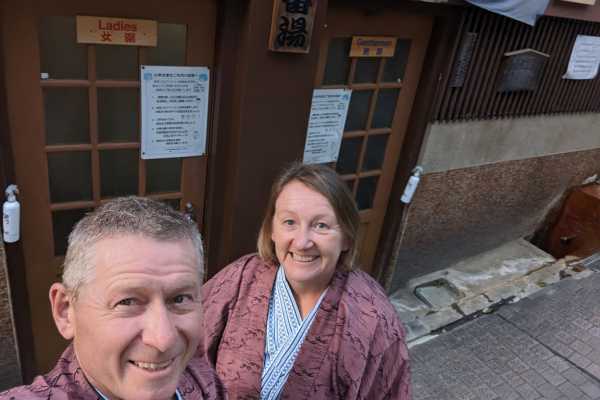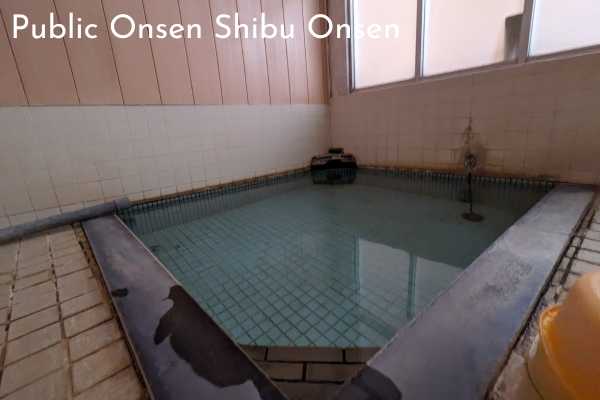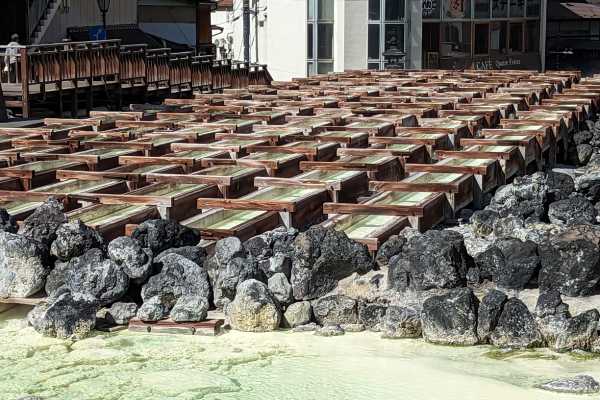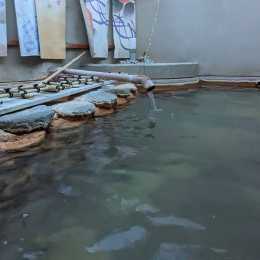There are more than 3,000 onsens in Japan, found throughout the country and these hot spring pools come in all shapes and sizes. There are outdoor pools, indoor pools and those that are traditional with more modern ones available too. Japanese onsens have a set of rules and etiquette that must be followed for their use. To the uninitiated, it can be quite daunting, but they are quite simple to follow. It is a unique opportunity to experience something that is on a Japanese bucket list. Our guide covers what to expect at an onsen, what rules to follow for onsen usage and where to find some of Japans best onsen towns.
THIS POST MAY CONTAIN COMPENSATED AND AFFILIATE LINKS MORE INFORMATION IN OUR DISCLAIMER
#1 THING TO DO
Best Way to Experience an Onsen
Stay at an onsen town in Japan. Book a ryokan, and explore the public onsens that aren’t available to the day trippers.
What is an Onsen?
Japanese onsens are naturally heated hot spring baths. Japan has heaps of (more than 25,000!) geothermal springs with mineral-rich waters that are said to have healing properties. Even if they don’t have healing properties they can be incredibly relaxing. Japan has more than 3,000 onsens, and there are specific onsen towns – like Shibu Onsen, Kinosaki Onsen town and Kusatu Onsen town. We’ve visited and stayed in all of those towns and in Ryokans that have specific hot water springs onsen too.
For a hot water pool to be called an onsen, then the water has to contain at least one of nineteen elements that occur naturally in the hot spring water. Plus it’s got to be at least 25C (77F) when it comes out of the ground.

Onsen Etiquette in Japan
In the same way that we were concerned first of all about staying at a Ryokan, oh boy were we worried about trying out a public onsen! So here’s all we learned and applied during our various onsen visits in Japan.
Leave your valuables locked in your room
Japan tends to be an extremely safe and honest country, however, you should leave your valuables locked in your room. Do not take them to the onsen. Onsens are hot and steamy places and you won’t need anything here with you.
Wear the Yukata and Geta Sandals
Using an Onsen is a very traditional Japanese thing to do. And so it goes without saying that wearing traditional clothes is a great way to visit. Especially if you’re visiting Onsen towns like Shibu Onsen or Kinosaki Onsen, you’re going to be visiting more than one onsen, so wearing clothes that are easy to put on and take off is essential.

Yukata are fabulous pieces of traditional Japanese clothing, they’re easy to wear. I wrote about how to put on a Yukata here. And if it’s cold when you’re visiting an onsen town, your ryokan will also provide you with a “Haori”- it’s a Japanese over jacket.
Geta Sandals are traditional wooden sandals that are worn too. They’re easy to get on and off, but not so easy to walk in. Most places that welcome Western visitors have a plastic version of them, which is much, much easier to walk in and much more likely to be available in larger sizes.
PRACTICAL TRAVEL TIPS
- 🛡️ Get Travel Insurance: Civitatis includes medical expenses, repatriation, theft, luggage delays. No deductibles or upfront payments. Get a quote here.
- 💰 Read about the Currency in Japan and ATM fees.
- 🔌 Check out Japan’s plug, socket & power situation.
- 📶 Internet, maps, and data on the go. eSims for Japan
Public Onsens are mostly gender-segregated
Unless you have a private onsen, then the onsens that are in onsen towns like Shibu Onsen or Kinosaki Onsen and your ryokan are gender segregated. So yes you’re going to get naked, but the only people who will see you are other members of your own gender. And trust me, they won’t be looking at you. They will more than likely be ignoring you.
There are some mixed-gender onsens, here’s where you can find some of them.
Do NOT take your camera or phone into the onsen
You can’t take photos of people in Japan without their permission and it goes without saying that taking photos of people in onsens is NOT allowed. Seriously. People are getting naked here. Leave your camera and your phone in your room. Don’t bring it to the onsen with you.
Undress in the changing area of an onsen
In public onsens and the shared baths in ryokans, there will always be a changing area. First of all, there will be somewhere for your sandals or shoes to go. It will likely be separate from where your clothes go. Each onsen is different. There will be lockers or boxes in which to put your room keys, your clothes and your yukata. Usually, this is fairly obvious as to where you put things.
Take the small towel that your ryokan provided with you into the onsen bath. The easiest way to carry it is to fold it up neatly and rest it on your head.
And then you progress, naked, into the cleaning up area. Yes. Naked. No swimsuits or bathing suits in the onsens.
If you have long hair tie it up to use the onsen
You don’t want your hair to be floating in the onsen bath water. Neither does anyone else want your hair to be floating in the onsen. If you’ve got hair to your shoulders, then tie it up.
Clean yourself before entering the bath
Whether you visit the onsen in your ryokan (private or shared) or a public onsen, you are required to clean yourself before entering the bath. There are always small stools, showers and cups for pouring water over yourself, as well as toiletries to clean yourself. So, sit on the small stool and wash yourself and get nice and clean. Once you are clean you can enter the onsen bath.
If there is no showering area (it’s not a shower like you’d have in the Western world, it is handheld, and you’re supposed to sit down on the small plastic stools so that you don’t spray water over other people) then you’re supposed to use the small cups that you find in the onsen, to use the onsen water to pour over yourself (and drain outside of the bath area) to rinse yourself off before entering the bath.

You use the baths naked.
It seems pretty obvious writing about it now. You don’t enter a shower at home with your bathing suit on. Neither do you wear a bathing suit in a Japanese onsen. It is completely normal to bathe in the onsens naked. Your ryokan will have provided you with a small onsen towel, but it’s not for wrapping around you (it’s usually tiny). You can take this small towel into the onsen with you, but if you do it’s considered traditional to fold it and put it on your head.

It’s used for wiping sweat off or drying yourself. Do NOT submerge the towel in the water.
Test the temperature of the water before entering
The temperature of onsens baths varies greatly. Even within the same town. Always test the temperature of the water first. In all baths, there will be a cold water tap, so that you can cool it down. It’s not going to be too cold. If anything it will always be too hot.
Do NOT leave the cold water tap running, some people prefer it to be hotter.
Do not put your head underwater in the onsen bath
In the same way that your towel doesn’t go into the water, neither does your head. It’s for hygiene reasons. If you have long hair, tie it up. And do NOT put your head into the water in the onsen bath. It’s okay to submerge your shoulders, but not your hair.
Keep your voice down in an onsen
These onsens are quiet places. If you’re onsen-ing with a friend then keep your voices low and your conversations private.
Dry off before you re-enter the changing area.
When you’ve had enough time in the onsen bath, you should exit the bath and dry off before you get back into the changing area. The changing area is supposed to be dry, so don’t be dripping wet when you return to it. You should dry off with your small towel provided by your ryokan.
Tattoos and Onsens in Japan
Most bathhouses and onsens prohibit those with tattoos from entering. If your tattoos are small, then you can cover them with special waterproof adhesive tape. If you have tattoos and want to use an onsen, then you should consider renting a ryokan room with a private onsen – alternatively, you can head to these places that specifically allow you to use an onsen if you have tattoos.
Onsen Towns that have multiple onsens to visit
With more than 3,000 onsens in the country, there are a number of towns that have sprung up (over the centuries) with several public onsens available. The most famous of these are
Shibu Onsen Town
Shibu Onsen is in Nagano Prefecture – my guide to Shibu Onsen town is here, and here are details of the 9 public onsens in town.

Here’s also the ryokans in Shibu Onsen town that have private (and shared) onsens.

Kinsosaki Onsen Town
Located in Northern Hyogo Prefecture Kinosaki Onsen town is a delight. There are 8 public onsens in Kinosaki and here’s all you need to know about Kinosaki Onsen town and the best ryokans to stay in Kinosaki Onsen.
Kusatsu Onsen Town
In the mountains of Gunma Prefecture, Kusatsu Onsen town is picture–postcard perfect in both summer or winter. You can bathe in Kusatsu Hot Springs, stay in a ryokan (I recommend this one) and also head along and explore the Yubatake – the hot water field, the symbol of Kusatsu.

Tips for Using Onsens in Japan
- Drink plenty of water between visits to the onsen. You’ll dehydrate in the hot water
- Keep your long hair tied up and out of the water
- Limit your visit to 10-15 minutes
- If you don’t feel well (the heat can be overwhelming), then get out CAREFULLY, and sit for a while. Don’t go back in. Drink some water. Don’t drink alcohol.
- Onsens might smell a little sulphurous – but you get used to it quickly and it’s not strong.
- You might want a shower (back at your ryokan) afterwards if you don’t like the smell.
JAPAN TRAVEL RESOURCES
TRAIN TICKETS
Easiest way to buy train tickets, use Klook for Shinkansen Train Tickets, check timetables & reserve seats.
Book Train Tickets
HOTELS AND APARTMENTS
See choices here
Sea view rooms? Budget rooms? Need a washing machine? The best choice of hotels & apartments.
TOURS & ATTRACTIONS
Most excursion choices, small group tours, skip-line tickets, free cancellation and top local guides.
Top options here.
CAR RENTAL GUIDE
Read my Guide
Best choice of vehicles, automatics, large or small cars, child seats. Book early for more options.
Final Words on Using Onsens in Japan
Whether you’re using the onsen baths in your ryokan or visiting one of Japan’s onsen towns this is a truly unique Japanese experience. It’s worth taking a little time to familiarise yourself with the rules and etiquette of onsens in Japan before heading there.
ASocialNomad is a participant in the Amazon Services LLC Associates Program, an affiliate advertising program designed to provide a means for sites to earn advertising fees by advertising and linking to amazon.com, amazon.co.uk, and amazon.ca. Amazon and the Amazon logo are trademarks of Amazon.com, Inc. or its affiliates. As an Amazon Associate, I earn from qualifying purchases.






One thought on “Onsen Etiquette – How to use Onsens in Japan”
thanks